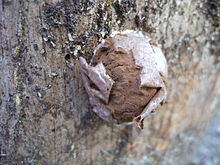Aethalium
As Aethalium refers to a form of the fruit body of slime molds . The plasmodium collects here and forms a single or a few spherical to cushion-shaped fruit bodies, which are protected by a membranous to coarse outer skin, the cortex. The spore-bearing structures inside are hardly delimited from one another. In evolutionary terms , they are the result of a fusion of sporangia , which can still be recognized from the occasional relics of peridia .
The aethalium should not be confused with the pseudoaethalium . At first glance, this also appears as a pillow-shaped structure. Inside, however, it can be seen that the individual sporangia are extremely close together and are clearly separated from one another by individual peridia.
Ethalies are often very large structures, the largest known specimen was found on sawdust in Sweden and measured 70 × 54 centimeters. Their representatives include conspicuous species such as the blood milk fungus or the yellow tan blossom .
proof
- ↑ a b c Heinrich Dörfelt , Gottfried Jetschke (ed.): Dictionary of mycology. 2nd Edition. Spektrum Akademischer Verlag, Heidelberg / Berlin 2001, ISBN 3-8274-0920-9 , p. 246.
- ↑ a b Wolfgang Nowotny: Myxomycetes (slime molds) and Mycetozoa (mushroom animals) - life forms between animals and plants . In: Wolfgang Nowotny (Ed.): Wolfsblut and Lohblüte. Life forms between animals and plants = Myxomycetes (= Stapfia . Band 73 ). Linz 2000, ISBN 3-85474-056-5 , p. 18–19 (German, English, French, Spanish). PDF on ZOBODAT
- ↑ John J. Lee: An Annotated Glossary of Protozoological Terms . In: John J. Lee, GF Leedale, P. Bradbury (Eds.): An Illustrated Guide to the Protozoa . tape 2 . Allen, Lawrence 2000, ISBN 1-891276-23-9 , pp. 1364 .
